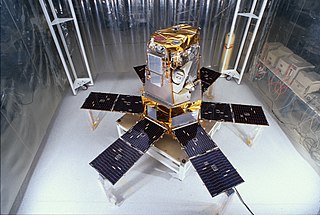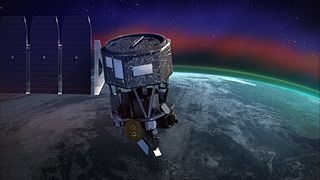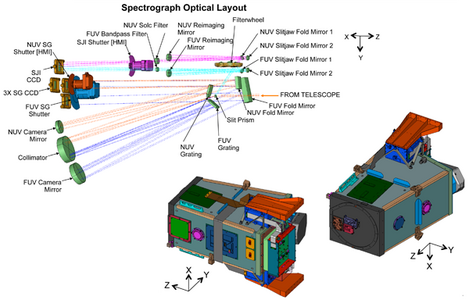High Energy Transient Explorer 1 (HETE-1) was a NASA astronomical satellite with international participation.

Galaxy Evolution Explorer was a NASA orbiting space telescope designed to observe the universe in ultraviolet wavelengths to measure the history of star formation in the universe. In addition to paving the way for future ultraviolet missions, the space telescope allowed astronomers to uncover mysteries about the early universe and how it evolved, as well as better characterize phenomena like black holes and dark matter. The mission was extended three times over a period of 10 years before it was decommissioned in June 2013. GALEX was launched on 28 April 2003 and decommissioned in June 2013.

NASA's series of Great Observatories satellites are four large, powerful space-based astronomical telescopes launched between 1990 and 2003. They were built with different technology to examine specific wavelength/energy regions of the electromagnetic spectrum: gamma rays, X-rays, visible and ultraviolet light, and infrared light.

Far Ultraviolet Spectroscopic Explorer represented the next generation, high-orbit, ultraviolet space observatory covering the wavelength range of 90.5–119.5 nanometre (nm) of the NASA operated by the Johns Hopkins University Applied Physics Laboratory. FUSE was launched on a Delta II launch vehicle on 24 June 1999, at 15:44:00 UTC, as a part of NASA's Origins Program. FUSE detected light in the far ultraviolet portion of the electromagnetic spectrum, which is mostly unobservable by other telescopes. Its primary mission was to characterize universal deuterium in an effort to learn about the stellar processing times of deuterium left over from the Big Bang. FUSE resides in a low Earth orbit, approximately 760 km (470 mi) in altitude, with an inclination of 24.98° and a 99.80 minutes orbital period. Its Explorer program designation is Explorer 77.

Reuven Ramaty High Energy Solar Spectroscopic Imager was a NASA solar flare observatory. It was the sixth mission in the Small Explorer program (SMEX), selected in October 1997 and launched on 5 February 2002, at 20:58:12 UTC. Its primary mission was to explore the physics of particle acceleration and energy release in solar flares.

Transition Region and Coronal Explorer was a NASA heliophysics and solar observatory designed to investigate the connections between fine-scale magnetic fields and the associated plasma structures on the Sun by providing high resolution images and observation of the solar photosphere, the transition region, and the solar corona. A main focus of the TRACE instrument is the fine structure of coronal loops low in the solar atmosphere. TRACE is the third spacecraft in the Small Explorer program, launched on 2 April 1998, and obtained its last science image on 21 June 2010, at 23:56 UTC.

International Ultraviolet Explorer, was the first space observatory primarily designed to take ultraviolet (UV) electromagnetic spectrum. The satellite was a collaborative project between NASA, the United Kingdom's Science and Engineering Research Council and the European Space Agency (ESA), formerly European Space Research Organisation (ESRO). The mission was first proposed in early 1964, by a group of scientists in the United Kingdom, and was launched on 26 January 1978 aboard a NASA Thor-Delta 2914 launch vehicle. The mission lifetime was initially set for 3 years, but in the end it lasted 18 years, with the satellite being shut down in 1996. The switch-off occurred for financial reasons, while the telescope was still functioning at near original efficiency.

The Solar Radiation and Climate Experiment (SORCE) was a NASA-sponsored satellite mission that measured incoming X-ray, ultraviolet, visible, near-infrared, and total solar radiation. These measurements specifically addressed long-term climate change, natural variability, atmospheric ozone, and UV-B radiation, enhancing climate prediction. These measurements are critical to studies of the Sun, its effect on the Earth's system, and its influence on humankind. SORCE was launched on 25 January 2003 on a Pegasus XL launch vehicle to provide NASA's Earth Science Enterprise (ESE) with precise measurements of solar radiation.
Solar physics is the branch of astrophysics that specializes in the study of the Sun. It intersects with many disciplines of pure physics and astrophysics.
The Lockheed Martin Solar and Astrophysics Laboratory (LMSAL) is part of the Lockheed Martin Advanced Technology Center (ATC) that is known primarily for its scientific work in the field of solar physics, astronomy and space weather. The LMSAL team is part of Lockheed Martin Space Systems and has close affiliations with NASA and the solar physics group at Stanford University.

CHIPS was a NASA Explorer program satellite. It was launched on 12 January 2003 from Vandenberg Air Force Base aboard a Delta II with the larger satellite ICESat, and had an intended mission duration of one year. CHIPS was the second of NASA's University Explorer (UNEX) mission class. It performed spectroscopy from 90 to 250 Angstrom extreme ultraviolet (EUV) light.

The Solar Dynamics Observatory (SDO) is a NASA mission which has been observing the Sun since 2010. Launched on 11 February 2010, the observatory is part of the Living With a Star (LWS) program.

Hinode, formerly Solar-B, is a Japan Aerospace Exploration Agency Solar mission with United States and United Kingdom collaboration. It is the follow-up to the Yohkoh (Solar-A) mission and it was launched on the final flight of the M-V rocket from Uchinoura Space Center, Japan on 22 September 2006 at 21:36 UTC. Initial orbit was perigee height 280 km, apogee height 686 km, inclination 98.3 degrees. Then the satellite maneuvered to the quasi-circular Sun-synchronous orbit over the day/night terminator, which allows near-continuous observation of the Sun. On 28 October 2006, the probe's instruments captured their first images.

The Extreme Ultraviolet Explorer was a NASA space telescope for ultraviolet astronomy. EUVE was a part of NASA's Explorer spacecraft series. Launched on 7 June 1992. With instruments for ultraviolet (UV) radiation between wavelengths of 7 and 76 nm, the EUVE was the first satellite mission especially for the short-wave ultraviolet range. The satellite compiled an all-sky survey of 801 astronomical targets before being decommissioned on 31 January 2001.

Ionospheric Connection Explorer (ICON) is a satellite designed to investigate changes in the ionosphere of Earth, the dynamic region high in our atmosphere where terrestrial weather from below meets space weather from above. ICON studies the interaction between Earth's weather systems and space weather driven by the Sun, and how this interaction drives turbulence in the upper atmosphere. It is hoped that a better understanding of this dynamic will mitigate its effects on communications, GPS signals, and technology in general. It is part of NASA's Explorer program and is operated by University of California, Berkeley's Space Sciences Laboratory.

The High Resolution Coronal Imager (Hi-C) is a sub-orbital telescope designed to take high-resolution images of the Sun's corona. As of 2020 it has been launched three times, but only the first and the third launches, on July 11, 2012, and May 29, 2018, resulted in a successful mission. It was launched aboard a Black Brant sounding rocket from White Sands Missile Range, New Mexico. The images taken were the highest resolution photos ever of the Sun's corona.

The Heliophysics Science Division of the Goddard Space Flight Center (NASA) conducts research on the Sun, its extended Solar System environment, and interactions of Earth, other planets, small bodies, and interstellar gas with the heliosphere. Division research also encompasses geospace—Earth's uppermost atmosphere, the ionosphere, and the magnetosphere—and the changing environmental conditions throughout the coupled heliosphere.

Student Nitric Oxide Explorer, was a NASA small scientific satellite which studied the concentration of nitric oxide in the thermosphere. It was launched in 1998 as part of NASA's Explorer program. The satellite was the first of three missions developed within the Student Explorer Demonstration Initiative (STEDI) program funded by the NASA and managed by the Universities Space Research Association (USRA). STEDI was a pilot program to demonstrate that high-quality space science can be carried out with small, low-cost free-flying satellites on a time scale of two years from go-ahead to launch. The satellite was developed by the University of Colorado Boulder's Laboratory for Atmospheric and Space Physics (LASP) and had met its goals by the time its mission ended with reentry in December 2003.

The Habitable Exoplanet Observatory (HabEx) is a space telescope concept that would be optimized to search for and image Earth-size habitable exoplanets in the habitable zones of their stars, where liquid water can exist. HabEx would aim to understand how common terrestrial worlds beyond the Solar System may be and determine the range of their characteristics. It would be an optical, UV and infrared telescope that would also use spectrographs to study planetary atmospheres and eclipse starlight with either an internal coronagraph or an external starshade.
Bart De Pontieu is a solar physicist who works at Lockheed Martin's Solar & Astrophysics Laboratory. He is known for his work on the dynamics and heating of the solar chromosphere, transition region and corona, via both wave mechanisms and nanoflares. De Pontieu has had a major role in multiple solar scientific space missions, including TRACE, Hinode, the Solar Dynamics Observatory, and IRIS. He is the Principal Investigator of the in-development Multi-Slit Solar Explorer selected by NASA in February 2022.
























